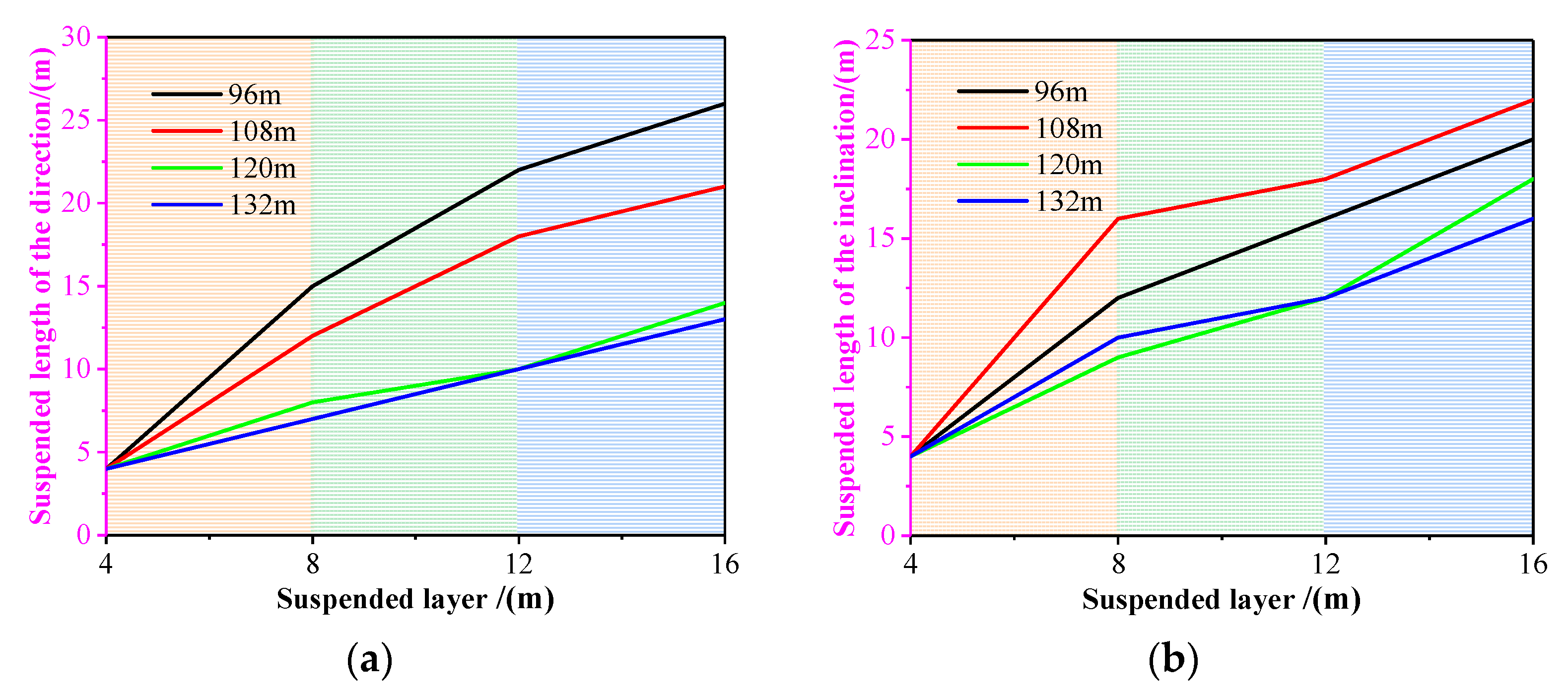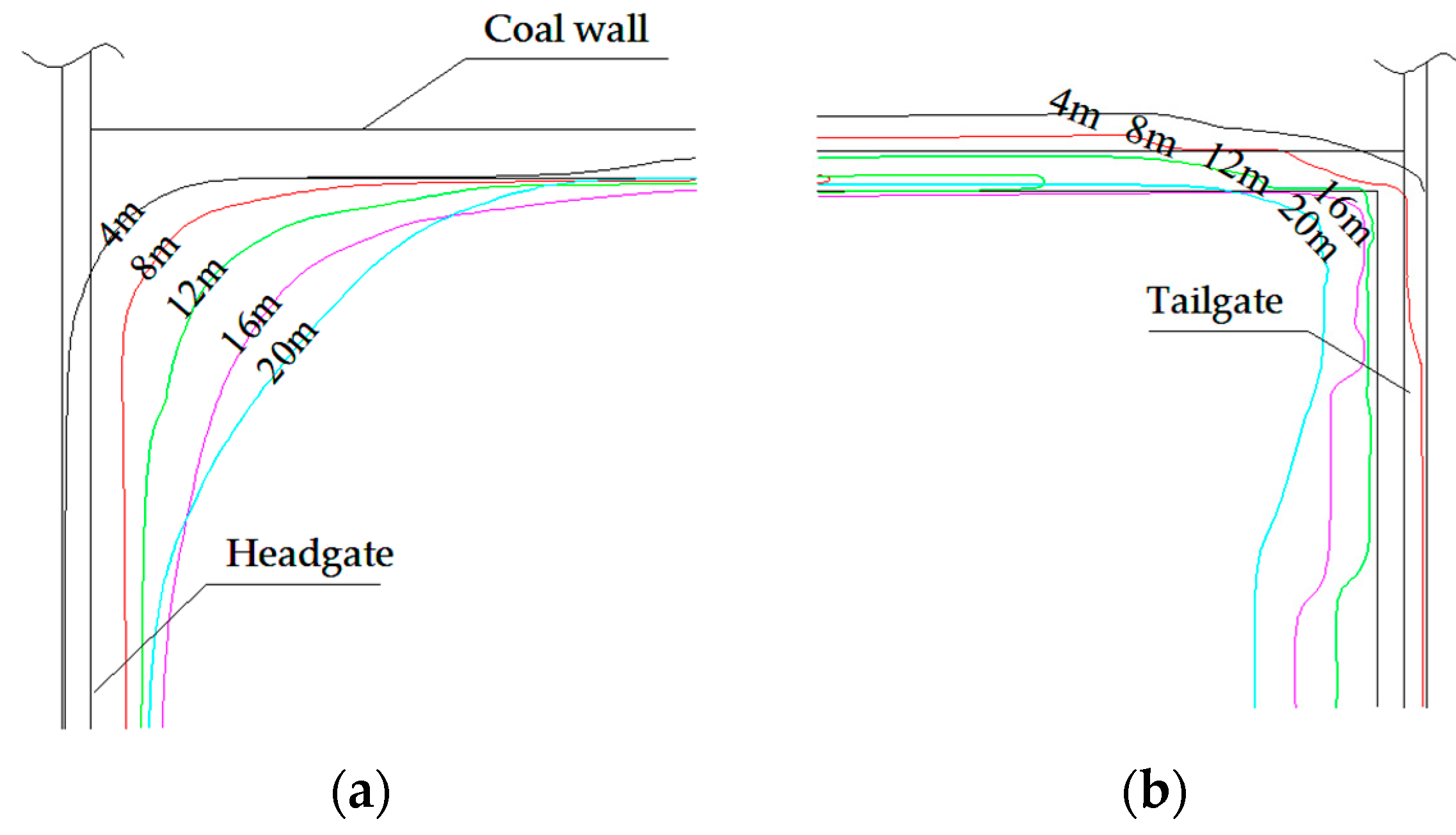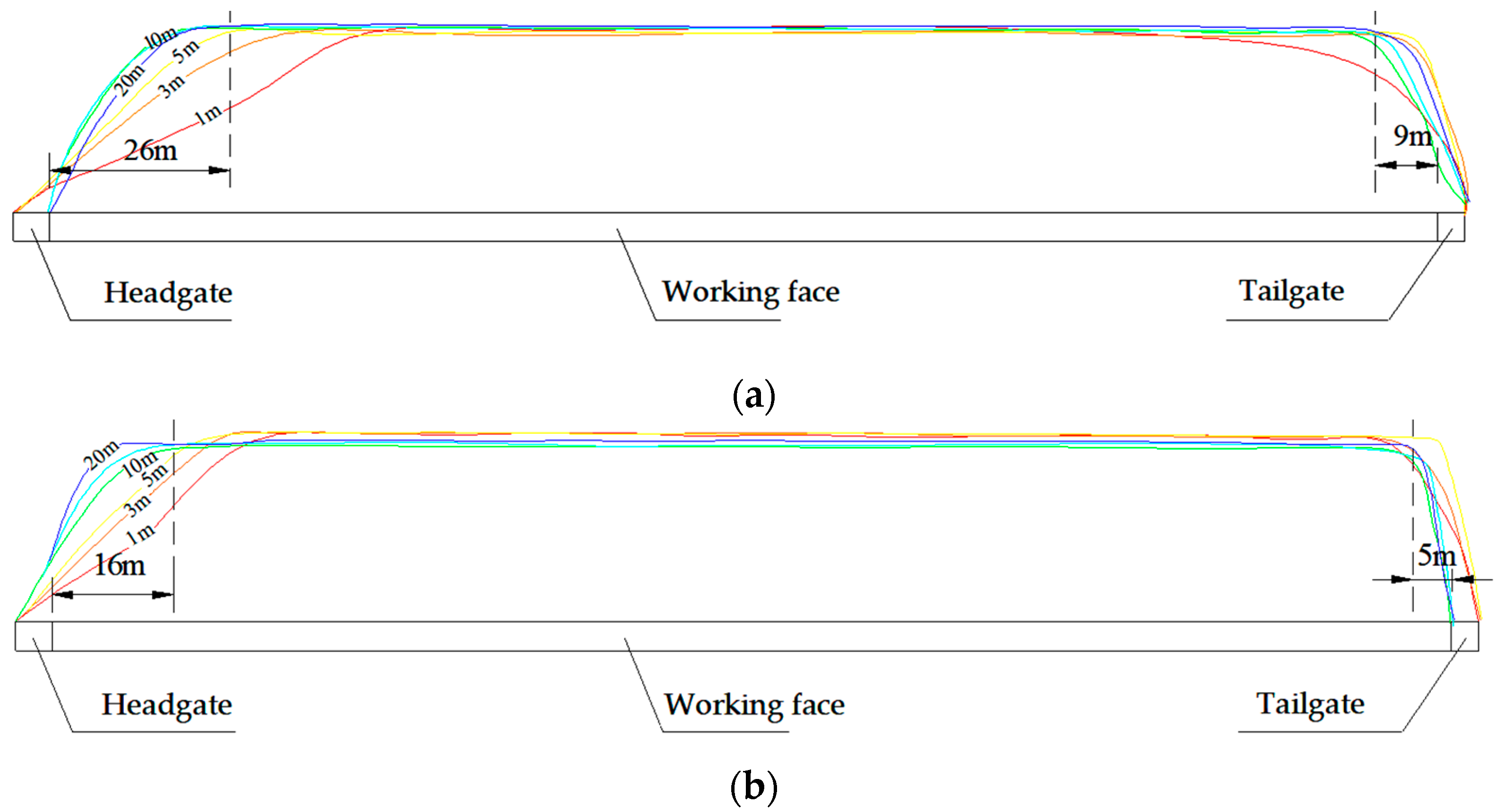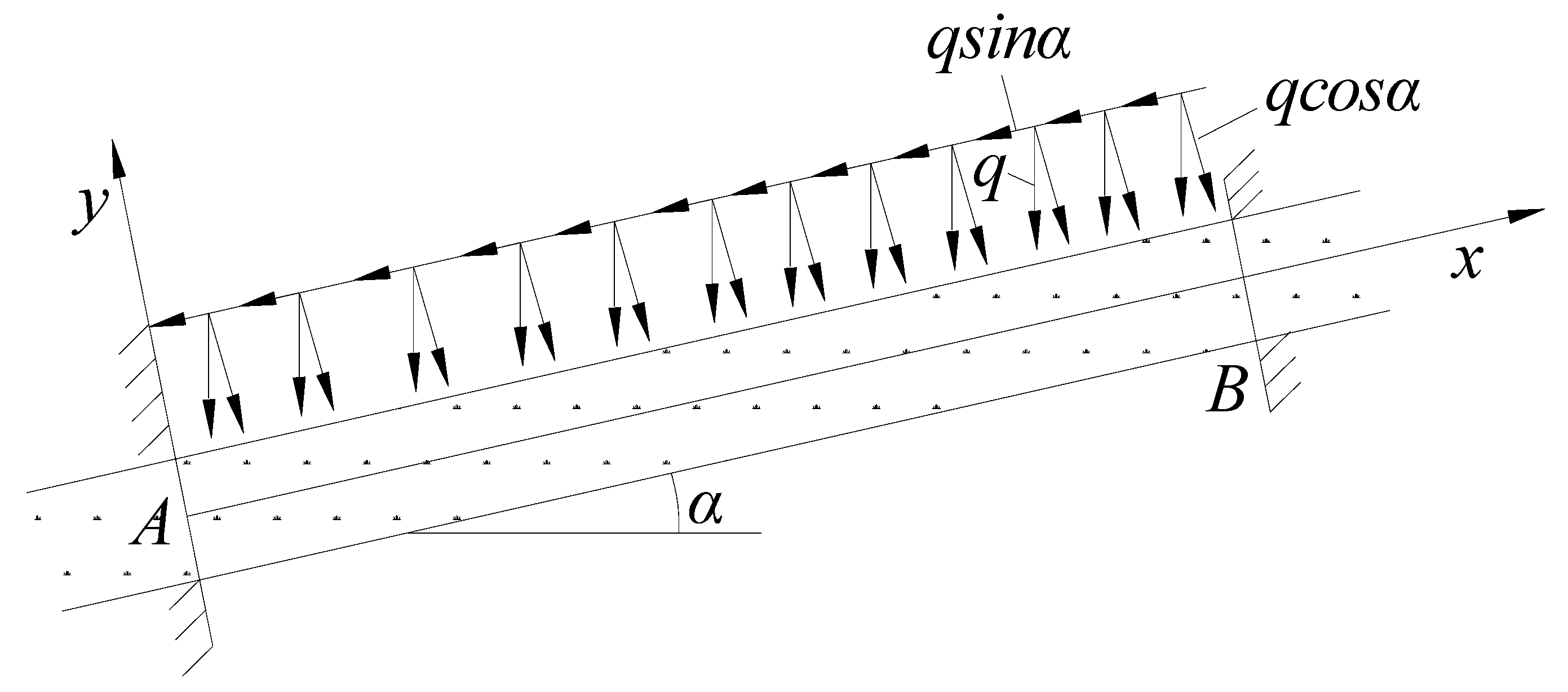Simulation Study on Spatial Form of the Suspended Roof Structure of Working Face in Shallow Coal Seam
Abstract
1. Introduction
2. Physical Simulation Experiment and Results
3. Numerical Simulation Calculations and Results
3.1. Establishment of the Model
3.2. Distribution Law of Suspended Roof Stress Field
- ①
- In the mining process, the shear stress contours were distributed in an arc shape at the face end, which is consistent with the measured suspended roof shape;
- ②
- The shear stress was larger on the side of the tailgate and smaller on the side of the headgate, and the largest shear stress occurred at the 8~12 m layer;
- ③
- The shear stress kept increasing in the 4~8 m layer, and the 8~20 m layer kept decreasing, and the largest shear stress occurred at the 8 m layer;
- ④
- As the roof layer increased, the shear stress contours moved to the back of the goaf. The 4~12 m layer was located 0~5 m in front of the coal wall, while the 12~20 m layer was located 0~5 m behind the coal wall in the 15210 working face.
- ①
- During the mining process, the maximum principal stress contour was arc-shaped at the face end, gradually decreasing from the coal wall to the goaf;
- ②
- With the increase in the roof layer, the maximum principal stress decreased, and the maximum principal stress contour extended to the back of the goaf;
- ③
- The maximum principal stress was more obvious on the headgate.
- ①
- When the working face advanced to 108 m, the shear stress distributions of different roof layers (4 m, 8 m, 12 m, 16 m, and 20 m) were plotted, which are shown in Figure 8a–e, and the basic laws were roughly the same. The arc-shaped transition area of the shear stress distribution at the 12 m layer had a small interval, which indicates that the hanging roof area collapsed at this time;
- ②
- The maximum principal stress distributions of different layers of the roof (4 m, 8 m, 12 m, 16 m, and 20 m) are shown in Figure 8f–j, and the basic law of their distribution was roughly the same;
- ③
- When the working face advanced to 120 m and 132 m, the law of the shear stress and maximum principal stress distribution at different layers (4 m, 8 m, 12 m, 16 m, and 20 m) of the roof were the same. Due to limitations in the scope of this paper, we will not list them one by one.
3.3. Evolution Law of the Shear Stress of Arc-Shaped Triangle Suspended Roof
3.4. Distribution of the Plastic Zone at the Face End of Roof
- ①
- The roof of the 4 m layer underwent a tensile–shear failure. The roof on the side of the tailgate was more damaged than the auxiliary headgate, and there was an obvious shear failure on the front of the roof. At the 4 m layer, the suspended roof on the side of the tailgate was not obvious, and the size of the suspended roof was about 4 × 4 m; the size of the suspended roof on the headgate was about 8 × 8 m;
- ②
- The roof at the 8 m layer incurred mainly a tensile–shear failure, and the roof in front of the coal wall had less shear failure. The hanging roof on the side of the tailgate was smaller, and the size of the tailgate was about 4 × 2 m. The stable roof was in the shape of an arc-shaped triangle behind the coal wall on the side of the headgate, and it revealed an obvious suspension phenomenon, the size of which was about 10 × 16 m;
- ③
- The plastic zone at the 4~16 m layer developed upwards in the shape of a stepped arc. However, the size of the suspended roof at the 16~20 m layer was unchanged.
3.4.1. The Space Form of the Roof Overhang at Different Levels at the End of the Roof
- ①
- The roof damage developed toward the goaf and the inner side of the coal pillar according to a certain breaking angle, and the damaged area gradually decreased with the increase in the roof layer (Figure 13a);
- ②
- On the side of the headgate, with the increase in the roof level, the damaged area decreased (Figure 13b), which indicates that the suspended roof area of the low-level roof was small, and the suspended roof area of the high-level roof was large;
- ③
- On the side of the tailgate, affected by the concentrated stress of the coal pillars in the upper coal seam section and the lateral supporting pressure of the adjacent working face of the coal seam, the size of the suspended roof on the side of the tailgate was relatively small;
- ④
- Along the slope of the working face, the upper and lower ends of the roof were broken to form a stepped, arc-shaped, three-hinged arch space structure, and the suspended roof periodically collapsed as the working face advanced.
3.4.2. Shape of the Plastic Zone along the Strike of the Overhanging Roof
- ①
- The plastic zone of the roof on the side of the headgate developed into an arc-shaped arch, as shown in Figure 14a, which confirms the preceding analysis;
- ②
- The roof fracture angle in the middle of the working face was larger, and the development height of the plastic zone was larger than that of the two ends, as shown in Figure 14b;
- ③
- Affected by the concentrated stress of the coal pillars in the section, the plastic zone of the roof on the side of the tailgate was fully developed, indicating that the roof collapse on the side of the tailgate was relatively timely, as shown in Figure 14c.
- ①
- When the working face advanced to 144 m, there were overhangs at both ends. The distribution of the roof plastic zone within 15 m from the goaf behind the coal wall was almost unchanged. The suspended roof area on the side of the transport chute was large, and the side of the return air chute was smaller;
- ②
- When the working face advanced to 168 m, the heads at both ends were suspended and collapsed. At this time, the roof plastic zone gradually developed backward and upward within 20m behind the coal wall. This shows that after the overhang at both ends collapsed, the overlying rock on the upper part was further damaged;
- ③
- Since the control roof distance of the support was 5.23~6.09 m, 3~5 m behind the coal wall was within the support range of the hydraulic support, and therefore the roof naturally did not break. Normally, there are overhangs 3 m and 5 m behind the coal wall in the inclined section.
- ①
- Before and after the roof of the end roof collapses, the size of the end hanging roof of the tailgate was small, and the side hanging roof always existed along the headgate;
- ②
- The higher the roof level, the larger the arc-shaped suspended roof area, and at a certain time, the suspended roof of the goaf is basically broken as a whole;
- ③
- The formation of the curved triangular suspended roof structure was affected by many factors, mainly including the direct roof and main roof thickness and strength, coal seam thickness and strength, coal pillar and roadway stability, etc.
4. Establishment of the Mechanical Structural Model at the Face End of the Roof
5. Conclusions
- (1)
- Through the three-dimensional physical simulation experiment, it was concluded that the suspension roof collapse interval was twice the periodic weighting interval, the suspended roof had 5~15 m layers, and the fractures developed in a stepped arc shape. The size of the lower suspended roof was small, and the higher suspended roof was large, thus forming a “stepped arc-shaped laminated” suspended roof structure. The suspended roof fracture was located on the side of the coal pillar of the headgate.
- (2)
- FLAC3D numerical analysis results revealed that the shear stress contours in the suspended roof were distributed in an arc shape and continuously moved to the back of the goaf as the layer of the suspended roof increased. The maximum principal stress contour was distributed in an arc shape and gradually decreased toward the upper layer and the back of the goaf. Combined with the distribution characteristics of the plastic zone in the suspended roof area, it was found that when the suspended roof collapsed, the 8 m ~ 12 m layers significantly changed, and the size of the suspended roof collapses reduced by about 60%.
- (3)
- Using the theory of thin elastic slabs, we found that as the working face advanced, the suspended roof bending moment gradually increased and finally reached the breaking limit at the junction of the fixed side and the free side, and the roof slabs at different layers broke from the bottom to the top. The stability of the stepped arc triangular structure was only related to the roof and supporting conditions. When the overlying load of the end suspended roof structure was larger, the suspended roof area was smaller.
Author Contributions
Funding
Institutional Review Board Statement
Informed Consent Statement
Data Availability Statement
Conflicts of Interest
References
- Peng, S. Topical areas of research needs in ground control a state of the art review on coal mine ground control. Int. J. Min. Sci. Technol. 2015, 25, 1–6. [Google Scholar] [CrossRef]
- Huang, Q.; He, Y.; Li, F. Research on overburden movement characteristics of large mining height working face in shallow buried thin bedrock. Energies 2019, 12, 4208. [Google Scholar] [CrossRef]
- Ritesh, L.; Murthy, V.; Kalendra, S. Semi-empirical model for predicting pot-hole depth in underground coal mining. Current Sci. 2018, 115, 1761–1769. [Google Scholar] [CrossRef]
- Dychkovskyi, R.; Shavarskyi, I.; Saik, P.; Lozynskyi, V.; Falshtynskyi, V.; Cabana, E. Research into stress-strain state of the rock mass condition in the process of the operation of double-unit longwalls. Min. Miner. Depos. 2020, 2, 85–94. [Google Scholar] [CrossRef]
- Shashenko, A.; Gapieiev, S.; Solodyankin, A. Numerical simulation of the elastic-plastic state of rock mass around horizontal workings. Arch. Min. Sci. 2009, 2, 341–348. [Google Scholar]
- Sadasivam, S.; Thomas, H.; Zagorscak, R.; Davies, T.; Price, N. Baseline geochemical study of the Aberpergwm mining site in the south wales coalfield. J. Geo. Exlpor. 2019, 202, 100–112. [Google Scholar] [CrossRef]
- Szurgacz, D.; Brodny, J. Analysis of the influence of dynamic load on the work parameters of a powered roof support’s hydraulic leg. Sustainability 2019, 11, 2570. [Google Scholar] [CrossRef]
- Wu, K.; Shao, Z.; Sharifzadeh, M.; Hong, S.; Qin, S. Analytical computation of support characteristic curve for circumferential yielding lining in tunnel design. J. Rock Mech. Geotech. Eng. 2022, 14, 144–152. [Google Scholar] [CrossRef]
- Liu, F.; Ma, Z.G.; Han, Y.S.; Huang, Z.M. Deformation rules for surrounding rock in directional weakening of end roofs of thin bedrocks and ultra thick seams. Adv. Civ. Eng. 2020, 8882374. [Google Scholar]
- Ghazdali, O.; Moustadraf, J.; Tagma, T.; Alabjah, B.; Amraoui, F. Study and evaluation of the stability of underground mining method used in shallow-dip vein deposits hosted in poor quality rock. Min. Miner. Depos. 2021, 3, 31–38. [Google Scholar] [CrossRef]
- Huang, Q.; Qian, M.; Shi, P. Structural analysis of main roof stability during periodic weighting in longwall face. J. China Coal Soc. 1999, 24, 581–585. [Google Scholar]
- Huang, Q.; Du, J.; Chen, J.; He, Y. Coupling control on pillar stress concentration and surface cracks in shallow multi-seam mining. Int. J. Min, Sci. Technol. 2021, 31, 95–101. [Google Scholar] [CrossRef]
- He, Y.; Huang, Q. Research on roof structure and determination of working resistance of shallow buried single key stratum based on grid-drillhole field method. Lithosphere 2022, 4328618. [Google Scholar] [CrossRef]
- Xu, J.; Ju, J. Structural morphology of key stratum and its influence on strata behaviors in fully- mechanized face with super large mining height. Chinese J. Rock Mech. Eng. 2011, 30, 1547–1556. [Google Scholar]
- Xu, J.; Zhu, W.; Ju, J. Supports crushing types in the longwall mining of shallow seams. J. China Coal Soc. 2014, 39, 1625–1634. [Google Scholar]
- Yan, S.; Yin, X.; Xu, H.; Xu, G.; Liu, Q.; Yu, L. Roof structure of short cantilever-articulated rock beam and calculation of support resistance in full-mechanized face with large mining height. J. China Coal Soc. 2011, 36, 1816–1820. [Google Scholar]
- Gong, P.; Jin, Z. Mechanical model study on roof control for fully-mechanized coal face with large mining height. Chinese J. Rock Mech. Eng. 2008, 27, 193–198. [Google Scholar]
- Huang, Q.; He, Y. Research on the roof advanced breaking position and influences of large mining height working face in shallow coal seam. Energies 2020, 13, 1685. [Google Scholar] [CrossRef]
- Deng, W. Research on reasonable hanging arch length of hard roof in fully mechanized coal mining face. Shanxi Coking Coal Sci. Technol. 2009, 4, 4–6. [Google Scholar]
- Zou, X.; Guan, Z. Research and application of end support technology in fully mechanized mining face. Shannxi Coal 2011, 30, 57–59. [Google Scholar]
- Wang, J.; Gong, S.; Zhou, S. Analysis of the structure of suspended triangle roof plate with curve side in fully-mechanized sublevel caving face. China Coal 2012, 38, 36–40. [Google Scholar]
- Xie, S.; Chen, D.; He, S.; Gao, M.; Sun, Y.; Pan, H. Analysis on thin plate model of main roof with elastic foundation boundary (II): Periodic fracture. J. China Coal Soc. 2017, 42, 3106–3115. [Google Scholar]
- Chen, Y.; Yuan, C. Formation mechanism and control technology of arc triangle hanging plate with curve side structure of coal mining face roof. J. Heilongjiang Uni. Sci. Technol. 2018, 28, 142–147. [Google Scholar]
- Li, Q.; Wu, G.; Kong, D.; Han, S.; Ma, Z. Study on mechanism of end face roof leaks based on stope roof structure movement under repeated mining. Eng. Fail. Ana. 2022, 135, 106162. [Google Scholar] [CrossRef]
- Kong, D.; Jiang, W.; Chen, Y.; Song, Z.; Ma, Z. Study of roof stability of the end of .working face in upward longwall top coal. Arab. J. Geosci. 2017, 10, 185. [Google Scholar] [CrossRef]
- Zhang, Z. Failure of hanging roofs in sublevel caving by shock collision and stress superposition. J. Rock Mech. Geotech. 2016, 8, 886–895. [Google Scholar] [CrossRef]
- Pavlova, L.; Fryanov, V.; Keller, A.; Tsvetkov, A. Numerical study of the effect of console length of the main roof hanging on the geo-mechanical parameters of the mine face. Int. Sci. Res. Conf. Knowl.-Based Technol. Dev. Util. Miner. Resour. 2019, 377, 012037. [Google Scholar]
- Guo, W.; Wang, H.; Dong, G.; Li, L.; Huang, Y. A case study of effective support working resistance and roof support technology in thick seam fully-mechanized face mining with hard roof conditions. Sustainability 2017, 9, 935. [Google Scholar] [CrossRef]
- Huang, B.; Wang, Y. Roof weakening of hydraulic fracturing for control of hanging roof in the face end of high gassy coal longwall mining: A case study. Arch. Min. Sci. 2016, 61, 601–615. [Google Scholar] [CrossRef]
- Huang, B.; Cheng, Q.Y.; Scoble, M. Using hydraulic fracturing to control caving of the hanging roof during the initial mining stages in a longwall coal mine: A case study. Arab. J. Geosci. 2018, 11, 603. [Google Scholar] [CrossRef]
- Sun, Y.; Bi, R.; Sun, J.; Zhang, J.; Taherdangkoo, R.; Huang, J.; Li, G. Stability of roadway along hard roof goaf by stress relief technique in deep mines: A theoretical, numerical and field study. Geomech. Geophys. Geo. 2022, 2, 1–16. [Google Scholar] [CrossRef]
- Sun, Y.; Li, G.; Zhang, J.; Huang, J. Rockburst intensity evaluation by a novel systematic and evolved approach: Machine learning booster and application. B. Eng. Geol. Environ. 2021, 11, 8385–8395. [Google Scholar] [CrossRef]
- Liu, J.W.; Liu, C.Y.; Yao, Q.L.; Si, G.Y. The position of hydraulic fracturing to initiate vertical fractures in hard hanging roof for stress relief. Int. J. Rock Mech. Min. 2020, 132, 104328. [Google Scholar] [CrossRef]
- Sher, E. Kolykhalov IV propagation of closely spaced hydraulic fractures. J. Min. Sci. 2011, 47, 741–750. [Google Scholar] [CrossRef]
- Lekontsev, M.; Sazhin, P. Directional hydraulic fracturing in difficult caving roof control and coal degassing. J. Min Sci. 2014, 50, 914–917. [Google Scholar] [CrossRef]
- He, Q.; Suorineni, F.; Oh, J. Review of hydraulic fracturing for preconditioning in cave mining. Rock Mech. Rock Eng. 2016, 49, 4893–4910. [Google Scholar] [CrossRef]
- Huang, B.; Liu, J.; Zhang, Q. The reasonable breaking location of overhanging hard roof for directional hydraulic fracturing to control strong strata behaviors of gob-side entry. Int. J. Rock Mech. Min. Sci. 2018, 103, 1–11. [Google Scholar] [CrossRef]























| Coal Mine | Working Face | Depth/m | Mining Height/m | Suspended Size/m Length × Width | Lithology of Roof (Main/Immediate Roof) |
|---|---|---|---|---|---|
| Zhangjiamao | 22210 | 90 | 6.0 | 4 × 3 | Quartz sandstone/Quartz sandstone |
| Zhangjiamao | 15210 | 210 | 5.8 | 18 × 10 | Fine-grained sandstone/siltstone |
| Hongliulin | 25210 | 175 | 5.8 | 10 × 6 | Fine-grained sandstone/siltstone |
| Bulainta | 22410 | 220 | 6.6 | 8 × 3 | Medium-grain sandstone/siltstone |
| Halagou | 22519-2 | 130 | 5.3 | 4 × 3 | Medium-grain sandstone/siltstone |
| Daliuta | 12201-1 | 80 | 3.6 | 10 × 3 | Fine-grained sandstone/siltstone |
| Shigetai | 31306 | 110 | 3.3 | 10 × 4 | Medium grain sandstone/siltstone |
| Shangwan | 12306 | 290 | 4.2 | 14 × 7 | Coarse-grained sandstone/siltstone |
| Yujialiang | 52209 | 150 | 3.9 | 10 × 4 | Medium grain sandstone/siltstone |
| Rock Stratum | Thickness h/m | Density ρ kg/m3 | Elastic Modulus E/GPa | Poisson’s Ratio μ | Cohesion C/MPa | Internal Friction Angle φ/° | Tensile Strength Rc/MPa |
|---|---|---|---|---|---|---|---|
| Red soil | 72 | 1580 | 0.06 | 0.25 | 0.09 | 30.0 | 0.12 |
| Mudstone | 3.0 | 2050 | 1.021 | 0.22 | 3.66 | 38.69 | 0.44 |
| FGS | 3.8 | 2450 | 0.803 | 0.21 | 2.54 | 38.13 | 1.87 |
| Mudstone | 12.6 | 2150 | 1.021 | 0.22 | 3.66 | 38.69 | 0.65 |
| Siltstone | 3.38 | 2470 | 0.826 | 0.19 | 3.13 | 39.29 | 1.75 |
| FGS | 28.97 | 2450 | 1.140 | 0.21 | 2.11 | 38.78 | 1.78 |
| 4−2 coal seam | 3.95 | 1390 | 0.435 | 0.21 | 1.16 | 36.98 | 0.74 |
| Mudstone | 3.2 | 2150 | 1.021 | 0.22 | 3.66 | 38.69 | 0.65 |
| FGS | 17 | 2430 | 1.112 | 0.17 | 2.64 | 40.40 | 1.24 |
| Mudstone | 8.9 | 2490 | 1.021 | 0.22 | 3.66 | 38.69 | 0.65 |
| Siltstone | 9.7 | 2320 | 0.824 | 0.23 | 2.42 | 38.60 | 1.24 |
| Mudstone | 10.16 | 2150 | 1.021 | 0.22 | 3.66 | 38.69 | 0.65 |
| FGS | 7.44 | 2590 | 1.829 | 0.13 | 4.68 | 37.59 | 2.61 |
| Siltstone | 15.45 | 2440 | 0.880 | 0.18 | 2.10 | 39.37 | 1.65 |
| 5−2 coal seam | 5.9 | 1390 | 0.266 | 0.14 | 1.45 | 37.60 | 0.82 |
| Siltstone | 10 | 2430 | 0.971 | 0.20 | 4.43 | 39.60 | 1.22 |
Disclaimer/Publisher’s Note: The statements, opinions and data contained in all publications are solely those of the individual author(s) and contributor(s) and not of MDPI and/or the editor(s). MDPI and/or the editor(s) disclaim responsibility for any injury to people or property resulting from any ideas, methods, instructions or products referred to in the content. |
© 2023 by the authors. Licensee MDPI, Basel, Switzerland. This article is an open access article distributed under the terms and conditions of the Creative Commons Attribution (CC BY) license (https://creativecommons.org/licenses/by/4.0/).
Share and Cite
He, Y.; Huang, Q. Simulation Study on Spatial Form of the Suspended Roof Structure of Working Face in Shallow Coal Seam. Sustainability 2023, 15, 921. https://doi.org/10.3390/su15020921
He Y, Huang Q. Simulation Study on Spatial Form of the Suspended Roof Structure of Working Face in Shallow Coal Seam. Sustainability. 2023; 15(2):921. https://doi.org/10.3390/su15020921
Chicago/Turabian StyleHe, Yanpeng, and Qingxiang Huang. 2023. "Simulation Study on Spatial Form of the Suspended Roof Structure of Working Face in Shallow Coal Seam" Sustainability 15, no. 2: 921. https://doi.org/10.3390/su15020921
APA StyleHe, Y., & Huang, Q. (2023). Simulation Study on Spatial Form of the Suspended Roof Structure of Working Face in Shallow Coal Seam. Sustainability, 15(2), 921. https://doi.org/10.3390/su15020921








